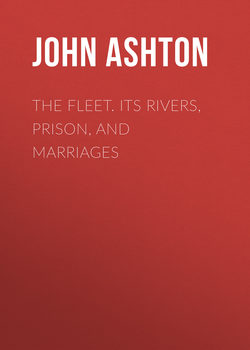The Fleet. Its Rivers, Prison, and Marriages

Реклама. ООО «ЛитРес», ИНН: 7719571260.
Оглавление
Ashton John. The Fleet. Its Rivers, Prison, and Marriages
The Fleet
CHAPTER I
CHAPTER II
CHAPTER III
CHAPTER IV
CHAPTER V
CHAPTER VI
CHAPTER VII
CHAPTER VIII
CHAPTER IX
CHAPTER X
CHAPTER XI
CHAPTER XII
CHAPTER XIII
CHAPTER XIV
CHAPTER XV
CHAPTER XVI
CHAPTER XVII
CHAPTER XVIII
The Fleet Prison
CHAPTER XIX
CHAPTER XX
CHAPTER XXI
CHAPTER XXII
CHAPTER XXIII
CHAPTER XXIV
CHAPTER XXV
Fleet Marriages
CHAPTER XXVI
CHAPTER XXVII
CHAPTER XXVIII
CHAPTER XXIX
CHAPTER XXX
Отрывок из книги
ONLY a little tributary to the Thames, the River Fleet, generally, and ignominiously, called the Fleet Ditch, yet it is historically interesting, not only on account of the different places through which its murmuring stream meandered, almost all of which have some story of their own to tell, but the reminiscences of its Prison stand by themselves – pages of history, not to be blotted out, but to be recorded as valuable in illustration of the habits, and customs, of our forefathers.
The City of London, in its early days, was well supplied with water, not only by the wells dug near houses, or by the public springs, some of which still exist, as Aldgate Pump, &c., and the River Thames; but, when its borders increased, the Walbrook was utilized, as well as the Fleet, and, later on, the Tye-bourne, or twin brook, which fell into the Thames at Westminster. In the course of time these rivulets became polluted, land was valuable; they were covered over, and are now sewers. The course of the Fleet being clearly traceable in the depression of Farringdon Street, and the windings of the Tye-bourne in the somewhat tortuous Marylebone Lane (so called from the Chapel of St. Mary, which was on the banks of "le bourne," or the brook1). Its further course is kept in our memory by Brook Street, Hanover Square.
.....
So much for the Conduit itself; but it, although inert, exercised a large share in the amusements of Londoners down to a comparatively recent period. It was pleasantly situated in the fields, and, until this century, during the latter half of which, the modern Babylon has become one huge mass of bricks and mortar, it served as a pleasant place of recreation for the Cits. There was an uninterrupted prospect of Hampstead and Highgate – which bounded the northern view, and which was purely pastoral, with the exception of sparsely-dotted farmhouses. There is a tradition that, on the site of the comparatively modern White Conduit House, was (in the reign of Charles I.), a tavern in the course of erection, and that, being finished, the workmen were carousing at the very moment of the monarch's decapitation.
Doubtless, in these suburban fields, there was, for very many years, a place for refreshment, which probably took the form, in the Arcadian age of the seventeenth and eighteenth century, of new milk, curds and whey, and syllabubs, for Islington was famous for its dairy produce, 24 as we know by the account of the entertainment given to Queen Elizabeth at Kenilworth Castle in 1575 by the Earl of Leicester, when the Squier Minstrel of Middlesex made a long speech in praise of Islington, whose motto was said to be, "Lactis Caseus infans."
.....